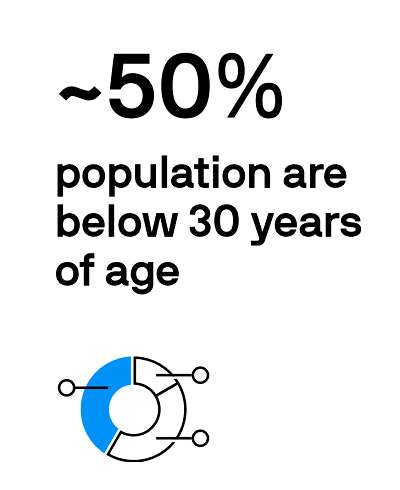What are active ETFs?
Active ETFs explained in 1 min
Key takeaways:
The Association of Southeast Asian Nations (ASEAN) is presenting compelling medium- and long-term growth opportunities even after the tumultuous pandemic years.
We share our high-conviction ideas on the regional grouping of 10 nations and where we see opportunities1.
Amid the current challenging times for global equities, Southeast Asia has been a relative bright spot1. This is in part due to the rebound in growth2 as the region’s economies reopen and transition to living with COVID-19.
The ongoing recovery in tourism has also buoyed growth, with China’s eventual reopening likely to provide a fresh boost in demand. China is Southeast Asia’s largest trading partner3 and accounts for more than 20% of tourists in the region.
While slowing external demand and tighter financial conditions could pose challenges to the near-term cyclical outlook, secular growth themes remain robust, supporting the long-term case for Southeast Asia equities.
Making the most of the demographic dividends of a young & growing population
At US$3.3 trillion in 2021, the Association of Southeast Asian Nations (ASEAN) has grown to be the world’s fifth largest economic bloc and the third largest in Asia3 . The regional grouping of 10 nations, which is also the fourth biggest trading group4 globally, continues to gain momentum with its mix of old and new economies.
With a population of 663.9 million, ASEAN is the third-most populous market after China and India3, and comprises nearly 9% of the world’s population. The region enjoys favourable demographics, with a relatively young and growing working population. Almost half of its people are below 30 years of age and its sizeable labour force is estimated to peak only in 2045, some three decades after China5.
This young, digitally savvy, productive and growing work force provides a long runway for growth as the region propels forward from a relatively low base.



.
With over 70% of the population either unbanked or underbanked6, there is ample runway for growth for financial services in ASEAN amid rising affluence.
Digital technologies are expected to unleash the growth potential of the sector with banks working actively to digitally transform, using technology to simplify account opening processes, enhance banking experience and expand access to banking services.
Rising interest rates amid an inflationary environment, more robust loan demand and increased adoption of technology should augur well for the sector, such as some banks in Indonesia7.
The relatively low penetration of e-commerce in the region also implies plenty of scope for growth.
The outbreak of the COVID-19 pandemic has accelerated the rate of adoption of digital services, with ASEAN’s internet economy estimated to grow to more than US$360 billion in gross merchandise value by 2025, from an estimated US$170 billion at the end of 20218. This growth is largely propelled by a fast-growing base of digital consumers and merchants as well as accelerating e-commerce and food delivery penetration.
Accelerating digital adoption and connectivity could drive opportunities in new economy areas.
ASEAN equities remains an underappreciated asset class, with foreign ownership hovering near record lows9.
Flows into ASEAN have lagged North Asia for some time, but green shoots are emerging. For one, the region remains well-placed for increasing foreign direct investments on account of meaningful improvements in the ease of doing business and favourable demographic profiles.
This is especially pertinent as companies look for new locations to diversify supply chains.
Investment opportunities in the “old economy” sectors as well as a multitude of “new economy” businesses, including beneficiaries of the digitalisation and decarbonisation megatrends, may stoke renewed interest in what for some time was a seemingly unloved region.
The transition to carbon neutrality is presenting new investment opportunities in ASEAN.
Currently, a significant share of power generation in the region comes from fossil fuels, such as coal, natural gas and oil. Given the global shift to less carbon-intensive energy generation, there is ample runway for growth in renewables in ASEAN. Renewable energy could account for 35% share of installed power capacity by 2025 and the region may need about US$360 million of investment in the power sector alone to help meet this target10.
Additionally, resource-rich locations in ASEAN could be important beneficiaries of the decarbonisation megatrend as global demand for important minerals like nickel – critical in stainless steel and electric vehicles (EV) battery production – accelerates. Indonesia, for instance, holds the world’s largest nickel ore reserves, accounting for a quarter of global production11.
Some locations in the region have also begun introducing policies to encourage the purchase and use of EVs, which presents new investment opportunities.
Conclusion
In conclusion, ASEAN benefits from long term structural trends such as favourable demographics, rising banking penetration and an acceleration in digital adoption and connectivity. ASEAN equities are a distinct subset of Asia and as such, a dedicated ASEAN portfolio may be a more impactful way to access these opportunities as wider Asian portfolios tend to be dominated by other markets.
J.P. Morgan Asset Management is a leading specialist in Southeast Asian markets, with a dedicated team of five ASEAN investment professionals with an average of 17 years of industry experience12, managing an all-weather portfolio of ASEAN equities..
Provided for information only based on market conditions as of date of publication, not to be construed as investment recommendation or advice. Forecasts, projections and other forward looking statements are based upon current beliefs and expectations, may or may not come to pass. They are for illustrative purposes only and serve as an indication of what may occur. Given the inherent uncertainties and risks associated with forecast, projections or other forward statements, actual events, results or performance may differ materially from those reflected or contemplated.
Diversification does not guarantee investment return and does not eliminate the risk of loss.
1. For illustrative purposes only based on current market conditions, subject to change from time to time. Not all investments are suitable for all investors. Exact allocation of portfolio depends on each individual’s circumstance and market conditions.
2. Source: CEIC, UBS Research. Data as of January 2022. Forecasts/ Estimates may or may not come to pass.
3. Source: “ASEAN Statistical Highlights 2022”, The ASEAN Secretariat, October 2022.
4. Source: UOB Economic-Treasury Research, Macrobond, Visual Capitalist. Data as of end-December 2020. Forecasts, projections and other forward looking statements are based upon current beliefs and expectations. They are for illustrative purposes only and serve as an indication of what may occur. Given the inherent uncertainties and risks associated with forecast, projections or other forward statements, actual events, results or performance may differ materially from those reflected or contemplated.
5. Source: Maybank KE, United Nations “World Population Prospects 2019”. Note: Working age defined as 15-64 years of age, ASEAN-6 refers to Indonesia, Malaysia, Philippines, Singapore, Thailand and Vietnam. Forecasts, projections and other forward looking statements are based upon current beliefs and expectations. They are for illustrative purposes only and serve as an indication of what may occur. Given the inherent uncertainties and risks associated with forecast, projections or other forward statements, actual events, results or performance may differ materially from those reflected or contemplated. Provided to illustrate macro trends, not to be construed as research or investment advice.
6. Source: Google & Temasek / Bain. 30.10.2019. Provided to illustrate macro trends, not to be construed as research or investment advice. Note: Population of individuals above age 18.
7. Source: “Top JPMorgan Asean Fund Has Indonesia, Banks as 2023 Picks”, Bloomberg, 09.11.2022.
8. Source: “e-Conomy SEA 2021”, Google, Bain & Company, Temasek, 10.11.2021.
9. Source: J.P. Morgan Research, Bloomberg, SETSMART, KSEI, Bursa Malaysia Berhad, PSE. Latest data as of 31.12.2021.
10. Source: “ASEAN Renewable Energy Outlook”, ASEAN Centre for Energy, 06.07.2021.
11. Source: “Indonesia On Track To Dominate The Supply Of Nickel To Make Batteries”, Forbes, 02.06.2021.
12. Source: J.P. Morgan Asset Management, data as of 31.10.2022. There can be no assurance that professionals currently employed by J.P. Morgan Asset Management will continue to be employed by J.P. Morgan Asset Management or that past performance or success of such professionals serve as an indicator of the professionals’ future performance or success.
This advertisement or publication has not been reviewed by the Monetary Authority of Singapore. It does not constitute investment advice, or an offer to sell, or a solicitation of an offer to buy any security, investment product or service. Informational sources are considered reliable but you should conduct your own verification of information contained herein. Investment involves risk. Investments in funds are not deposits and are not considered as being comparable to deposits. Past performance is not indicative of future performance and investors may not get back the full or any part of the amount invested. Dividend distributions if any are not guaranteed and are made at the manager’s discretion. Fund’s net asset value may likely have high volatility due to its investment policies or portfolio management techniques. The value of the units in the scheme and the income accruing to the units, if any, may fall or rise. Funds which are invested in emerging markets, smaller companies and financial derivative instruments may also involve higher risks and are usually more sensitive to price movements. Any applicable currency hedging process may not give a precise hedge and there is no guarantee that any hedging will be successful. Investors in a currency hedged fund or share class may have exposure to currencies other than the currency of their fund or share class. Investors should make their own investigation or evaluation or seek independent advice prior to making any investment.Please refer to the Singapore Offering Documents (including the risk factors set out therein) and the relevant Product Highlights Sheet for details at https://am.jpmorgan.com/sg/en/asset-management/per/. To the extent permitted by applicable law, we may record telephone calls and monitor electronic communications to comply with our legal and regulatory obligations and internal policies. Personal data will be collected, stored and processed by J.P. Morgan Asset Management in accordance with https://am.jpmorgan.com/sg/en/asset-management/per/privacy-statement/. Issued by JPMorgan Asset Management (Singapore) Limited (Co. Reg. No. 197601586K). All rights reserved.